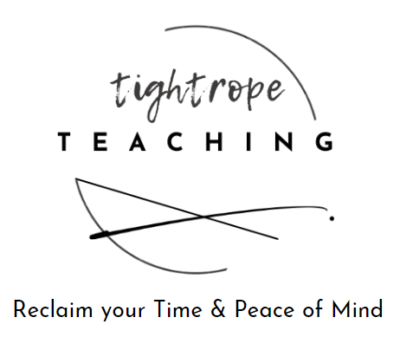
I know you’re counting down the days to summer, and the last thing you probably want to think about right now is returning to school next Fall.
But unless you’re switching careers, you WILL be returning…and don’t you want to make that transition back as easy on yourself as possible?
Nugget: Sometimes reducing overwhelm is reactive (picking up the pieces, repairing the holes, making changes mid-stream), and sometimes reducing overwhelm is proactive (setting yourself up for a lighter load to begin with, preventing yourself from the situation you’re in right now).
So even though I know you just want to keep your eye on that summertime prize, a few simple, intentional moves in the spring (now) before you check out can make a huge difference in reducing your stress level come August.
While it is pretty easy to mentally shift into summer mode, it can be really difficult to shift those same rusty gears back into school mode and really get mentally “in the zone.” You can make the transition back to school easier for yourself in several ways, and that’s something Future You will say “thank you” for!
1. Leave yourself notes in your planner
For years I used a hardcopy planner book for all my lessons; nowadays I use an electronic calendar instead (high tech: google docs table). But in both cases, I am CONSTANTLY writing myself notes about what worked great (do this again!) and what needs to be tweaked (need 1 more day for this next time). Then, when I go to re-teach this material in a new semester, I have all my annotations right there.
If you’ve already been doing this this year, then planning next year will be SO much easier. But if you haven’t been doing this, it’s ok: start now, and if you can, look back over your calendar from this year and write in any mental notes that you can still remember-–because if you’re anything like me, you DEFINITELY won’t remember it in August!
2. Give an Exit Survey
This is something I’ve done for years and I actually really look forward to!
As a student, the only time I experienced this was in college: on the last day of class the professor would leave a big manila envelope full of course evaluations and #2 pencils, designate a student in charge of collecting them and then leave the room because they weren’t allowed to be in there to influence our answers.
I do this with my own high school students, but I change the format a bit: I use a google form and set it up to receive anonymous responses, telling the students explicitly and repeatedly that this won’t affect their grade in any way. I make it mostly multiple choice so that they are more likely to complete it (less work) with room at the end for “any other comments or feedback” in paragraph format. It’s a quick and simple setup, but it gives me so much valuable information. I really look forward to reading these as it gives me great insight into the class experience from their perspective. It also makes students feel respected and heard. The responses on these forms I definitely take into account when considering what to keep or change the following year (which is relevant here because it overlaps with planning).
3. Set up your lesson plans and materials for the first week of school before leaving for the summer.
Trust me, I KNOW you’re tired at the end of the year.
I KNOW how tempting it is to just do the bare minimum requirement and then PEACE OUT.
But every time I have disciplined myself to do this one thing, I have been SO grateful to myself in the Fall.
Before leaving for the summer, fully plan out your first week back, in as much detail as you can. This includes prepping any materials that you can do ahead of time, like making photocopies or gathering supplies needed.
We all know that the teacher workdays leading up to the first day of school leave very little time for actual work that teachers need to do: it’s mostly filled with faculty meetings, required trainings, new initiatives, and doing things like setting up your online LMS and physical classroom space.
I know how the stress and anxiety can creep up as you watch the hours tick by in those meetings, thinking of ALL the things you COULD be doing in your classroom to get ready for your actual students on the first day. I also know what it feels like to have that stuff already done and NOT be stressing out in those meetings. That’s the feeling I want for you next year!
Set yourself up for success
For me, the longer I teach, the quicker I can switch into “summer mode” and be 100% present in it (like, the moment I leave the parking lot on the last day of school)…It wasn’t always this way, though. So even if it takes you some time to “come down” from school mode and fully engage in summer mode, I encourage you to be fully present in the time off that you have; it’s crucial to recharging for the next school year.
You can help yourself let go of school mode easier if you know that you have taken care of these small things to set yourself up for a less stressful start to your school year in the Fall.
“August You” says Thanks!

Pingback: Lessen Your End-of-Year Stress: Start Early! - Tightrope Teaching
Pingback: How to Survive the Final Stretch - Tightrope Teaching